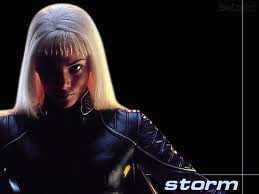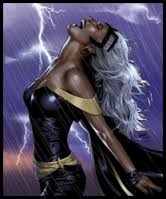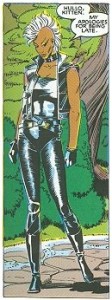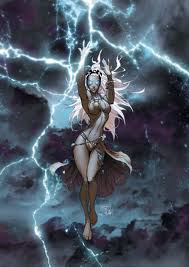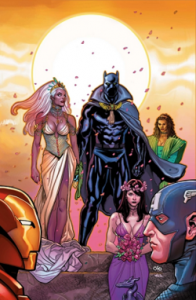Storm

Wolverine and The X-Men – Storm Scenes
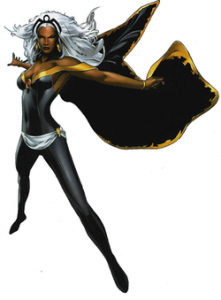 Storm, drawn by Greg Land, 2005
Storm, drawn by Greg Land, 2005
Storm (Ororo Munroe) is a fictional character that appears in a number of comic books published by Marvel Comics. The character first appeared in Giant-Size X-Men #1 (May 1975), and was created by writer Len Wein and artist Dave Cockrum. Best known as a longtime member and sometimes leader of the X-Men, Storm is the former queen consort of Wakanda, a title once held by marriage to King T’Challa, better known as the Black Panther.
Storm is one of the most frequently seen X-Men, having appeared in most of the comic books, all of the animated television series, nearly all of the video games, and the live-action X-Men film series, where she is portrayed by actress Halle Berry.
Publication history – Origin of Storm (1970’s)
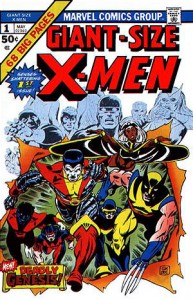 Cover to Giant-Size X-Men #1, 1975. Art by Gil Kane & Dave Cockrum.
Cover to Giant-Size X-Men #1, 1975. Art by Gil Kane & Dave Cockrum.
Storm first appeared in 1975 in Giant-Size X-Men #1, written by Len Wein and pencilled by Dave Cockrum. In this comic, Wein uses a battle against the living island Krakoa to replace the first-generation X-Men of the 1960’s with new X-Men. Storm was an amalgamation of two characters Cockrum created: The Black Cat and Typhoon. The Black Cat had Storm’s costume, minus the cape, and was submitted for the new X-Men’s original lineup. However, during a hiatus in the new X-Men project, other female cat characters like Tigra were introduced, making the Black Cat redundant. Since the creative team did not want the X-Men to have an all-male lineup, editor Roy Thomas suggested that Cockrum make his character Typhoon, originally designed as a male, into the woman of the group. Cockrum liked the idea, and outfitted Typhoon with The Black Cat’s costume, a cape, and a new haircut with white hair. His collaborators feared that Storm’s white hair would make her look like a grandmother, but Cockrum, confident that he could consistently draw the character so that she would appear young, insisted on this aspect of her appearance.
Chris Claremont followed up Wein as the writer of the flagship title Uncanny X-Men in 1975, writing many notable X-Men stories, among them God Loves, Man Kills and Dark Phoenix Saga, which respectively served as the basis for the films X2: X-Men Unitedand X-Men: The Last Stand. In both arcs, Storm is written as a major supporting character. Claremont stayed the main writer of X-Men for the next 16 years and consequently wrote most of the publications containing Storm.
Backstory
In Uncanny X-Men #102 (December 1976), Claremont established Storm’s backstory. Ororo’s mother, N’Dare, was the princess of a tribe in Kenya and descended from a long line of African witch-priestesses with white hair, blue eyes, and a natural gift for sorcery. N’Dare falls in love with and marries American photojournalist David Munroe. They move to Harlem in uptown New York City, where Ororo is born. They move to Egypt and lived there until they die during the Suez Crisis in a botched aircraft attack, leaving six-year-old Ororo as an orphan. Her violent claustrophobia is established as a result of being buried under tons of rubble after that attack. She becomes a skilled thief in Cairo under the benign Achmed el-Gibar and wanders into the Serengeti as a young woman. She is worshipped as a goddess when her powers appear before being recruited by Professor X for the X-Men.
Claremont further fleshed out Storm’s backstory in Uncanny X-Men #117 (January 1979). He retroactively added that Professor X, who recruits her in Giant Size X-Men #1 of 1975, had already met her as a child in Cairo. As Ororo grows up on the streets and becomes a proficient thief under the tutelage of master thief Achmed el-Gibar, one of her most notable victims was Charles Francis Xavier, later Professor X. He is able to use his mental powers to temporarily prevent her escape and recognizes the potential in her. However, when Xavier is attacked mentally by Amahl Farouk, the Shadow King, the two men are preoccupied enough with their battle to allow the girl to escape. Both Xavier and the Shadow King recognize Storm as the young girl later.
In the following issues, Claremont portrayed Storm as a serene, independent character. Although Storm was initially written having trouble adjusting to Western culture, e.g. calling the obligation to cover herself up in a public bath “absurd,” she earns a lot of respect: in Uncanny X-Men #139 (November 1980), Claremont established her as the leader of the X-Men after Cyclops took a leave of absence, a position she holds in various incarnations. Claremont also made Storm especially harbor motherly feelings for the youngest X-Man, 13-year old Kitty Pryde. In Marvel Team-Up #100 (December 1980), Claremont wrote a short story in which he retroactively established that Storm, then 12 years old, saves a young Black Panther from racist thugs when they both are in Kenya. This story would later become a base for later writers to establish a deeper relationship between both characters.
In X-Men Annual #5, the X-Men travel with the Fantastic Four to help Arkon the Imperion defeat lizard-like Badoon invaders who had taken over his kingdom. Storm and Arkon share a kiss at the end of the issue, as she turns down his offer to make her his queen.
In the early eighties, adventures of Storm written by Claremont included a space opera arc, in which the X-Men fight parasitic beings called the Brood. Storm is infected with a Brood egg and contemplates suicide, but then experiences a last-minute save by the benign whale-like Acanti aliens. In the following arc, Claremont further established Storm’s character strength. He wrote a story in which Storm’s fellow X-Man Angel is abducted by a rogue mutant group called the Morlocks. The X-Men are hopelessly outnumbered, and Storm is rendered sick by the Morlock called Plague. To save Kitty’s life, Storm challenges the Morlocks’ leader Callisto, in a duel to the death for leadership of the Morlocks. Despite being violently sick, she defeats Callisto by impaling her with a knife and nearly kills her.
In Uncanny X-Men #173, October 1983, writer Claremont and artist Paul Smith created a new look for Storm, abandoning her old costume for black leather top and pants, and changing her former veil of white hair into a punk Mohawk. In a 2008 interview, Smith regretted the change as “a bad joke gone too far … I knew that they were going to cut the hair, so as a joke I put a Mr. T mohawk on her … [editor] Louise Simonson said ‘We’re gonna get hung [sic] no matter what we do, so let’s commit the crime!’ So we went with the Mohawk … But once you get into the whole leather and stud thing it was a bad joke that got way out of hand.”
In the actual story, Storm’s outlook on life darkens after her struggles with the Brood. These changes alienate her from Kitty for a time. Storm is influenced in this by Yukio, a friend of Wolverine, and the two become fast friends. Claremont wrote an arc in which fellow mutant Forge develops a mutant power neutralizing gun. The intended target is another X-Man, Rogue, but Storm is hit instead, taking away her powers. Forge takes her back to his home in Dallas, Texas to recover. With his help, she adjusts to life without her powers, and they fall in love. When Storm leans that Forge built the weapon that took her powers, she is heartbroken and leaves him.
By 1986, the question arose of whether the X-Men would be led by Storm or by Cyclops, who was now married to Madelyne Pryor and an expectant husband. The two settled the matter in a duel in the Danger Room that saw Storm victorious. It was later revealed during the “Inferno” storyline that Madelyne’s nascent psychic abilities had emerged during that duel, unbeknownst to her or anyone, and that she had subconsciously used those abilities to influence the duel. During the 1988 “Fall of the Mutants” storyline, Claremont wrote arcs in which Storm is trapped in another dimension with Forge and regains her elemental powers, and is captured by the evil cyborg Nanny. Although believed slain in that encounter, she resurfaced, having become amnesiac as a result of being physically regressed to childhood by Nanny. She is hunted by the evil telepath Shadow King and framed for murder, and finally returns to thieving before regaining her memories. In the following arc, The X-Tinction Agenda, she is kidnapped to the mutant-exploiting fictional nation of Genosha and is temporarily transformed into a brainwashed mutate, but is in the end restored physically and mentally to her adult prime.
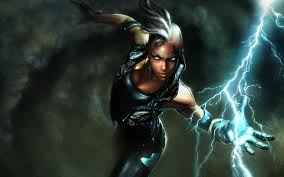 Growth as a character (1990’s)
Growth as a character (1990’s)
In October 1991, the X-Men franchise was re-launched, centering on the new eponymous X-Men (vol. 2) comic. Claremont wrote Storm as the leader of the X-Men’s Gold Team; the other team, Blue, is led by her colleague Cyclops, the X-Man she once succeeded as leader. When Claremont left the X-Men comic after 16 years since his debut in Uncanny X-Men #94 (1975), he was replaced by Jim Lee, who continued portraying her as a strong leader. In the sister title Uncanny X-Men, now under Scott Lobdell, Lobdell continued on the romance between Storm and Forge eventually having Forge propose to Storm in 1992. Storm hesitates and is about to say yes when Forge misinterprets her reaction and rescinds his offer before Storm can speak. Lobdell waited until November 1993 before he let a deeply hurt Storm and Forge make up with each other. In 1995, Lobdell continued with an arc which pitted the X-Men against the Morlocks again. As Claremont did with Callisto in 1983, Lobdell let Storm end the battle by wounding her opponent in the heart. This time, Storm rips out one heart of the two-hearted Morlock girl Marrow, who had fixed a bomb to it. In February 1996, Storm got her first miniseries, the eponymous Storm. In these four issues, Warren Elliswrote a story in which Storm is sucked into an alternate dimension and pitted against villain Mikhail Rasputin.
In X-Treme X-Men, conceived by a newly-reinstated Chris Claremont in July 2001, Storm was written as the leader of this team of more streetwise X-Men, including the former thief Gambit, former Brotherhood member Rogue, Sage, anti-hero Bishop, Psylocke, and the more tame third hero known as Thunderbird. This was in contrast to its more strait-laced sister titles, Uncanny X-Men andNew X-Men. In the period until its end in issue #46 (June 2004), Claremont continued to write Storm as the central character. During this time, Storm enjoys a brief flirtation with younger fellow X-Man Slipstream and is kidnapped by the intergalactic warlord Khan. Khan wants to make her his queen, but Storm defeats him. In the series, she also becomes leader of the fictional X-Treme Sanctions Executive, a special police task force of mutants policing mutants given worldwide authority.
In the aftermath of the 2005 House of M storyline (written by Brian Michael Bendis), 90% of the mutants lost their powers. Storm is among the 198 mutants who retain their powers. Also in that year, the miniseries Ororo: Before the Storm of Mark Sumerak retold her backstory in greater detail, concentrating on her relationship with surrogate father figure Achmed el-Gibar during her childhood.
In the following year, Marvel Comics announced that Ororo would marry fellow African super hero Black Panther. Collaborating writer Eric Jerome Dickey explained that it was a move to explicitly target the female and African American audience. Storm’s history with Black Panther, including the initial meeting of the characters, was retconned by Marvel during the lead up to their marriage. Initially, in Marvel Team-Up #100 (1980), Storm is seen at age twelve rescuing Black Panther from a white racist called Andreas de Ruyter, but in Dickey’s miniseries, T’Challa saves Ororo (who is still twelve) from de Ruyter and his brother. A Black Panther #24 (2006) flashback is ambiguous when it comes to the physical aspect of their first meeting, while the miniseries depicts Ororo losing her virginity to T’ Challa a few days after they meet. Collaborating writer Axel Alonso, editor of Black Panther, has stated: “Eric’s story, for all intents and purposes (…) is Ororo’s origin story.” The relationship led to the marriage of the two most prominent black African Marvel Comics heroes in Black Panther #18 by writer Reginald Hudlin, July 2006, as a tie-in to the Civil War storyline. Marvel Comics editor-in-chief Joe Quesada was highly supportive of this marriage, stating it was the Marvel Comics equivalent of the marriage of “Lady Diana and Prince Charles,” and he expected both characters to emerge strengthened. Shawn Dudley, the Emmy-Award Winning Costume Designer for TV’s Guiding Light designed Storm’s wedding dress, which was revealed in the April 17 issue of TV Guide, though the design was greatly altered for the comic event. Quesada’s prediction has begun to be born out in a Black Panther story arc that followed Storm and T’Challa’s wedding where the newly married couple go on a World Tour, meeting with other known royalties such as Doctor Doom, Namor, and Black Bolt of the Inhumans. With Mister Fantastic and the Invisible Womantaking time off to work on their marriage in the aftermath of the Civil War, Storm and Black Panther become temporary members of the Fantastic Four alongside the Human Torch and the Thing in 2007. Storm later returned to the Uncanny X-Men.
Storm later joins the reformed Astonishing X-Men (#25). She states that her official reason for joining the team is that Wakanda is a supporter of Mutantes Sans Frontieres and she believes she should be on the front line, however she is also somewhat bored of her life as queen. The reemergence of the Shadow King later forces Storm to choose between her role as queen and her role as an X-Man. Confronting the Panther God Bast, Storm asserts that she is not limited to being one or the other or anything else and that she is unafraid to do whatever is necessary to fulfill those responsibilities. Regaining Bast’s favor, the two defeat the Shadow King and Storm decides that she will remain Queen of Wakanda and remain with the X-Men, refusing to choose between them. Seeking to re-learn his limitations, T’Challa later leaves Africa and takes a new role as the guardian of Hell’s Kitchen following the events of Shadowland; Though the two remain a couple, Storm sadly but respectfully accepts T’Challa’s request for temporary isolation so that he can find himself.
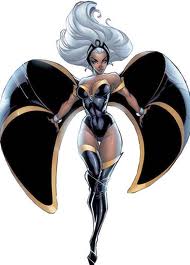 After the 2011 revamp of the X-Men related comic books Storm appears as the leader of a defensive, reconnaissance based team of X-Men in the on-going X-Men title. It was announced on October 15, 2011 that Storm will be joining the Avengers, beginning inAvengers Vol. 4 #19 released in November 2011. However, she leaves the team to fight alongside the X-Men during the return of the Phoenix, resulting in her facing T’Challa when he sides with the Avengers. When a Phoenix-empowered Namor destroys Wakanda, Storm realizes the X-Men are out of control and returns to help the Avengers. However, she is stunned when T’Challa tells her he has annulled their marriage.
After the 2011 revamp of the X-Men related comic books Storm appears as the leader of a defensive, reconnaissance based team of X-Men in the on-going X-Men title. It was announced on October 15, 2011 that Storm will be joining the Avengers, beginning inAvengers Vol. 4 #19 released in November 2011. However, she leaves the team to fight alongside the X-Men during the return of the Phoenix, resulting in her facing T’Challa when he sides with the Avengers. When a Phoenix-empowered Namor destroys Wakanda, Storm realizes the X-Men are out of control and returns to help the Avengers. However, she is stunned when T’Challa tells her he has annulled their marriage.
X-Men
In 2013, Marvel revealed an all new all female series simply named X-Men. Written by Brian Wood with art by Olivier Coipel, X-Men will feature an all-female cast including Storm, Jubilee, Rogue, Kitty Pryde, Rachel Grey and Psylocke.

